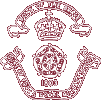| Navigation links at the bottom of this page |
| |
1812 The Royal Hospital Chelsea |
The Royal Hospital Chelsea, retirement, haven and nursing home for British soldiers is an institution as old as the British Army itself. Founded in 1660, it annually celebrates its Founders Day close to 29 May (the birthday of King Charles II). In contrast, the Royal Military Asylum (RMA), founded in 1801 by HRH Frederick Duke of York and Albany is old by contemporary standards of dating institutions, but considerably younger than the Royal Hospital whose in-patients are known simply as Chelsea pensioners. For over a century, these two institutions, the Royal Hospital and RMA, existed side by side. Before the RMA was in 1892 renamed the Duke of York's Royal Military School and moved in 1809 to new quarters on the White Cliffs of Dover, it occupied a site on King's Road, Chelsea. The Royal Hospital was a stone's throw around the corner on what is today the Royal Hospital Road. The two institutions were connection by Franklins Row.
|
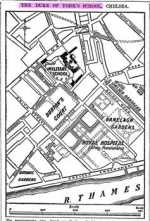 |
|
The first intake of military orphans to the RMA came from Major General Sir George Hewett's orphanage on the Isle of Wight. A party of boys and girls, mostly orphans of the 27 Foot, the Royal Inniskilling Fusiliers, arrived on 29 August 1903 having travelled from the Isle of White escorted by General Hewett himself with the children in two carrier carts the charge of Nurse Bold and an unnamed sergeant. The journey from London took four days and, passing over the Battersea Bridge, it passed through the grounds of the Royal Hospital to get to the then newly-built RMA. For this reason, the convoy must have passed in the full view of the resident Chelsea pensioners. The Royal Hospital Road was not then in existence.
The RMA lacked a burial ground of its own. Children who died in the Asylum were buried in one of the church graveyards of Chelsea, depending on their religion. Some members of the RMA staff, such as the institutions first commandant, Lt. Colonel George Williamson, were honoured with full military honours and put to rest in the burial ground of the Royal Hospital.
|
RMA, Chelsea (c1812) |
|
|
|
 |
|
| Many boys of the Royal Military Asylum enlisted in the British Army, often in the regiments in which their fathers and grandfathers had served. Others became schoolmaster sergeants or followed a musical career, attending Kneller Hall and becoming bandmasters.
Many, after a long military career, returned to Chelsea to be admitted as in-pensioners of the Royal Hospital and, in turn, came in contact with children of the Asylum while it occupied its Chelsea premises. Nor may one forget the hundreds of soldiers' daughters who once were admitted to the RMA before a branch for girls was opened in Southampton.
|
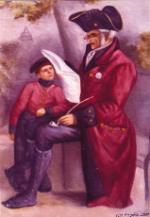 |
| Chelsea pensioner with RMA lad (c1809) |
|
|
 |
|
|
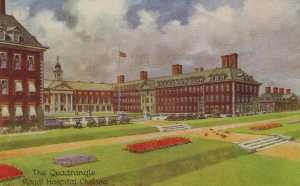 |
The Royal Hospital, Chelsea, showing the quadrangle and a view of the centre court in which stands a fine bronze statue of King Charles II by Grinling Gibbons. |
|
 |
|
Founders Day celebrated each year close to 29 May, the birthday of King Charles II, also known as Oak Apple Day, which commemorates the escape of the future King after the Battle of Worcester in 1651 when he hid in an oak tree to avoid capture. |
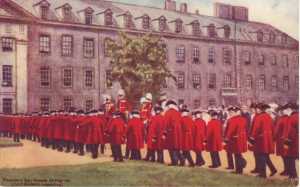 |
 |
|
|
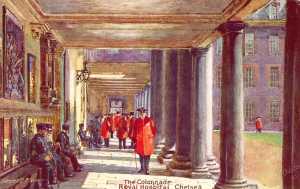 |
The colonnade, a covered and panelled walk where pensioners can stretch their legs or sit, rest and occupy themselves reminiscing about their time in the service. |
|
 |
|
The Great Hall, panelled in oak that, for a 100 years was the main dining room, now a recreation room decorated with captured standards and oil paintings. |
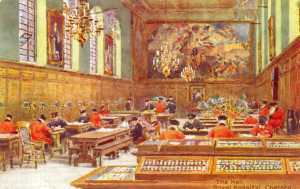 |
| Sincere thanks are due to Peter Goble of Knaresborough, North Yorks, for permission to reproduce his colourful image of a Chelsea pensioner in tricorn hat and topcoat with a boy of the RMA. Also, equally sincere thanks to Fiona Archontoulis of Brisbane, Australia for sharing with us this quartet of 1911 post cards of the Royal Hospital, Chelsea. |
 |
|
|
|

